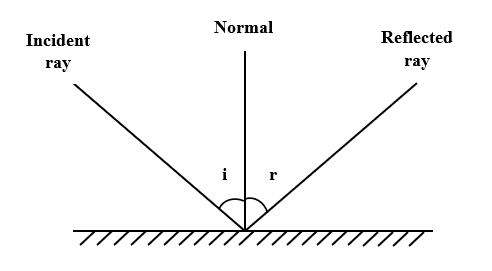
State the laws of reflection.
Answer
477.3k+ views
Hint: Reflection is the phenomenon of bouncing back of light by an object. To answer this question, consider a light incident upon the surface present in the same medium and gets reflected back. The light ray gets reflected from the same plane on which the light is incident. There is another law related to the angle of incidence and angle of reflection. This information can be used to state the two laws of reflection.
Complete answer:

When a light ray is reflected from a surface, it obeys specific laws. These laws are known as Laws of reflection. There are two laws of reflection which are as follows:
1. The first law of reflection states that the incident ray, reflected ray, angle of incidence (i), angle of reflection (r) and the point of incidence i.e. normal all lie on the same plane as shown in the above figure.
2. The second law of reflection states that the angle of incidence is equivalent to angle of reflection. If the incident ray falls on the plane of a mirror along the normal at 90°, then the reflected ray will travel along the same path.
Note:
The laws of reflection are valid to all the reflecting surfaces including spherical mirrors. Students must remember that changing the angle of incidence will also change the angle of reflection but both will still be in the same plane. The laws of reflection only hold true for reflection in the same medium, however if the medium is different there are separate laws governing this phenomenon. There are laws of refraction as well. So, students must not get confused between laws of reflection and laws of refraction.
Complete answer:

When a light ray is reflected from a surface, it obeys specific laws. These laws are known as Laws of reflection. There are two laws of reflection which are as follows:
1. The first law of reflection states that the incident ray, reflected ray, angle of incidence (i), angle of reflection (r) and the point of incidence i.e. normal all lie on the same plane as shown in the above figure.
2. The second law of reflection states that the angle of incidence is equivalent to angle of reflection. If the incident ray falls on the plane of a mirror along the normal at 90°, then the reflected ray will travel along the same path.
Note:
The laws of reflection are valid to all the reflecting surfaces including spherical mirrors. Students must remember that changing the angle of incidence will also change the angle of reflection but both will still be in the same plane. The laws of reflection only hold true for reflection in the same medium, however if the medium is different there are separate laws governing this phenomenon. There are laws of refraction as well. So, students must not get confused between laws of reflection and laws of refraction.
Recently Updated Pages
Express the following as a fraction and simplify a class 7 maths CBSE

The length and width of a rectangle are in ratio of class 7 maths CBSE

The ratio of the income to the expenditure of a family class 7 maths CBSE

How do you write 025 million in scientific notatio class 7 maths CBSE

How do you convert 295 meters per second to kilometers class 7 maths CBSE

Write the following in Roman numerals 25819 class 7 maths CBSE

Trending doubts
Give 10 examples of unisexual and bisexual flowers

Draw a labelled sketch of the human eye class 12 physics CBSE

Differentiate between homogeneous and heterogeneous class 12 chemistry CBSE

Differentiate between insitu conservation and exsitu class 12 biology CBSE

What are the major means of transport Explain each class 12 social science CBSE

Draw a diagram of a flower and name the parts class 12 biology ICSE




